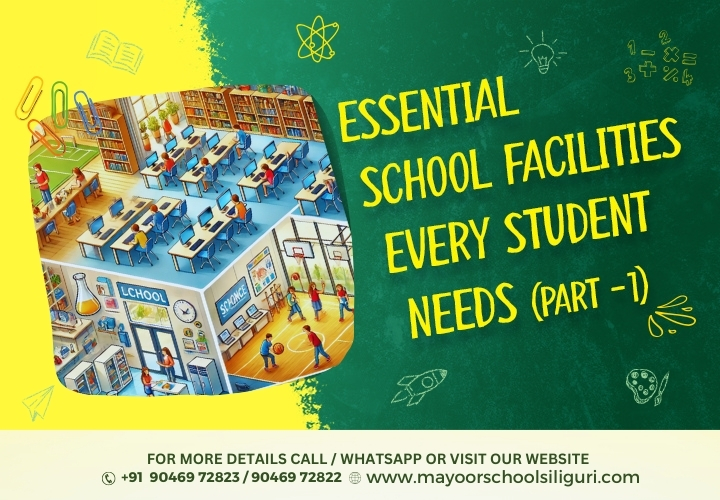Schools
play a critical role in shaping young minds, and the facilities they provide
can significantly impact the quality of education and overall student
well-being. As we explore the essential school facilities every student needs,
it's crucial to consider how these elements contribute to a nurturing
educational experience.
1.
Classrooms: The Heart of Learning
Classrooms
are the primary spaces where teaching and learning occur. They should be
well-equipped, spacious, and designed to accommodate different learning styles.
Here are some key aspects of an ideal classroom:
- Comfortable
Seating: Ergonomic
chairs and desks that can be adjusted to accommodate students of various
sizes and learning preferences.
- Adequate
Lighting: Natural
lighting, supplemented by adjustable artificial lights, helps create a
conducive learning atmosphere and reduces eye strain.
- Technology
Integration:
Interactive whiteboards, projectors, and Wi-Fi connectivity are the
examples of modern classroom technology that enhances learning by
incorporating multimedia resources.
- Climate
Control: Proper
ventilation and temperature control systems ensure a comfortable
environment, regardless of external weather conditions.
2.
Libraries: A Gateway to Knowledge
Library
and Learning Resources serve as a
hub for information, offering a vast collection of books, digital resources,
and study materials. A well-equipped library fosters a love for reading and
research among students:
- Diverse
Collection: Access to
a wide range of books including fiction, non-fiction, reference materials,
and e-books which, caters to students' diverse interests.
- Study
Spaces: Quiet
study areas provide students with options for individual and collaborative
learning.
- Librarian
Assistance: Skilled
librarians guide students in research, encouraging critical thinking and
information literacy skills.
3.
Computer Laboratory: Encouraging Exploration
Computer
Labs are essential for hands-on learning and
experimentation, allowing students to apply theoretical concepts in a practical
setting:
- Comfortable
Workstations: Ergonomically designed furniture
ensures students can work comfortably for extended periods. Adjustable chairs,
spacious desks, and proper lighting reduce physical strain and enhance focus.
- Educational Software:
Offering a wide range of educational software tailored to different subjects
can help students explore topics more deeply. For example, design tools for art
classes.
- Open Layout:
An open and flexible layout encourages collaboration. Movable furniture and
ample space allow students to work in groups, facilitating peer-to-peer
learning and the exchange of ideas.
4.
Sports Facilities: Promoting Physical Well-being
Physical
education is vital for students' overall development, promoting health,
teamwork, and discipline. Sports and Recreation Areas include:
- Playgrounds
and Fields: Ample
outdoor spaces for sports like football, cricket, and children’s park
area.
- Indoor play
area: Facilities for indoor
sports, play activity, badminton, fitness classes, and physical training
ensure year-round physical activity.
- Swimming
Pools: Teaching
swimming skills and hosting aquatic events contributes to physical fitness
and safety awareness.
- Coaching
and Equipment: Access to
qualified coaches and proper sports equipment enhances skill development
and competitive spirit.
5.
Arts and Music Facilities: Fostering Creativity
Arts
and music education plays a crucial role in nurturing creativity and emotional
expression. Schools should provide
- Art and
Music Rooms: Equipped
with supplies for drawing, painting, sculpture, and other visual arts.
Music instruments, and acoustic equipment for individual practice and
group performances.
- Theatres
and Auditoriums: Spaces for
drama productions, dance performances, and cultural events promote
artistic expression and confidence.
- Exhibition
Spaces: Galleries
for showcasing student artwork encourage appreciation and critique of
visual arts.
6.
Technology Labs: Preparing for the Future
In
today's digital age, technology literacy is essential. Schools need to equip
students with the skills to navigate the digital world:
- Language Labs: Access to computers, software, and high-speed
internet supports learning in different languages.
- FIM: First in Maths is a software where students can
learn maths through games. The students use the software on their
computers to play and learn maths in a fun way. It is an encouraging
opportunity for the students and they will never feel bored with
mathematics.
- IT Support: On-site technical support ensures the smooth
functioning of technological resources and addresses student needs…… (TO BE CONTINUED)
Posted On: 26/07/2024
